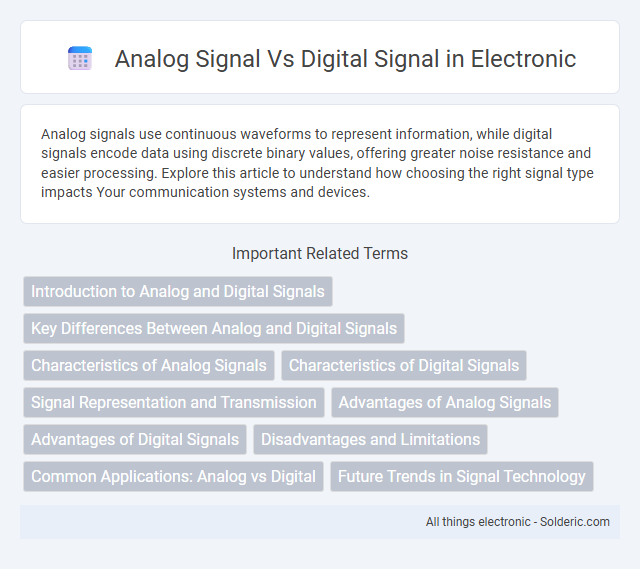Analog signals use continuous waveforms to represent information, while digital signals encode data using discrete binary values, offering greater noise resistance and easier processing. Explore this article to understand how choosing the right signal type impacts Your communication systems and devices.
Comparison Table
| Feature | Analog Signal | Digital Signal |
|---|---|---|
| Signal Type | Continuous wave | Discrete binary values (0s and 1s) |
| Data Representation | Variable amplitude and frequency | Fixed amplitude and frequency (digital levels) |
| Noise Sensitivity | High, prone to degradation | Low, easier error detection and correction |
| Signal Quality | Degrades over distance | Maintains quality over long distances |
| Bandwidth Usage | Generally less efficient | Typically more efficient |
| Complexity | Simple processing and hardware | Complex processing and hardware |
| Examples | Radio waves, voice signals, analog audio | Computers, digital audio, data transmission |
| Storage | More prone to quality loss | Lossless or minimal degradation |
| Applications | Traditional broadcasting, analog phones | Modern communications, digital media |
Introduction to Analog and Digital Signals
Analog signals represent continuous variations of physical quantities such as sound, light, or temperature, characterized by smooth and infinite data points. Digital signals encode information using discrete binary values, typically 0s and 1s, enabling efficient data processing and storage. Understanding the fundamental differences between analog and digital signals is essential for applications in telecommunications, electronics, and signal processing.
Key Differences Between Analog and Digital Signals
Analog signals represent continuous waveforms that vary smoothly over time, capturing real-world information such as sound and light with infinite resolution. Digital signals encode data in discrete binary formats, typically using 0s and 1s, enabling robust noise immunity and easy storage, processing, and transmission. Key differences include analog's susceptibility to noise and signal degradation versus digital signals' ability to maintain integrity through error detection and correction techniques.
Characteristics of Analog Signals
Analog signals vary continuously over time, representing information through fluctuations in amplitude, frequency, or phase. These signals are susceptible to noise and distortion, affecting signal quality during transmission or processing. Understanding the characteristics of analog signals helps you optimize systems for applications requiring smooth, natural data representation.
Characteristics of Digital Signals
Digital signals feature discrete levels, typically represented by binary values 0 and 1, which enable precise data encoding and reduced noise interference compared to analog signals. These signals exhibit robustness in transmission, allowing for error detection and correction, resulting in higher reliability and improved communication quality. Your digital devices leverage these characteristics to ensure efficient processing and accurate representation of information.
Signal Representation and Transmission
Analog signals represent data through continuous waveforms that vary in amplitude or frequency, enabling smooth signal variations for natural phenomena like sound and light. Digital signals encode information as discrete binary values (0s and 1s), allowing for more precise, noise-resistant transmission and easier error detection during communication. Your choice between analog and digital signal transmission impacts signal quality, bandwidth efficiency, and system complexity in various applications such as audio, video, and data networks.
Advantages of Analog Signals
Analog signals offer continuous data representation, providing smooth and natural sound or image quality ideal for audio and video applications. They exhibit better resolution in capturing real-world variations, making them suitable for environments where subtle changes must be detected. Your equipment can benefit from analog signals when nuanced and detailed signal processing is essential.
Advantages of Digital Signals
Digital signals offer superior noise resistance, ensuring clearer and more reliable data transmission compared to analog signals. They enable efficient data compression and encryption, enhancing security and storage capacity in communication systems. Furthermore, digital signals facilitate easy integration with modern computing technologies, supporting advanced functionalities like error detection and correction.
Disadvantages and Limitations
Analog signals suffer from susceptibility to noise and signal degradation over long distances, which reduces data accuracy and quality. Digital signals, while less prone to noise, face limitations such as increased bandwidth requirements and potential quantization errors during analog-to-digital conversion. Both signal types encounter challenges in maintaining fidelity and efficient transmission depending on environmental and technical conditions.
Common Applications: Analog vs Digital
Analog signals dominate in audio transmission, traditional broadcasting, and analog sensors due to their continuous waveform, providing smooth and natural signal representation. Digital signals are prevalent in modern communications, computing, and digital storage, enabling error correction, efficient compression, and integration with computer systems. Industries such as telecommunications, media streaming, and digital electronics rely heavily on digital signals for high fidelity and data security.
Future Trends in Signal Technology
Future trends in signal technology are rapidly advancing towards enhanced digital signal processing due to its superior noise resistance and efficient data compression capabilities. Innovations in quantum computing and AI-driven algorithms are set to revolutionize the way digital signals are transmitted and interpreted, offering unprecedented accuracy and speed. Your ability to leverage these emerging digital signal technologies will be crucial for staying ahead in communication and data analysis fields.
Analog signal vs digital signal Infographic

 solderic.com
solderic.com